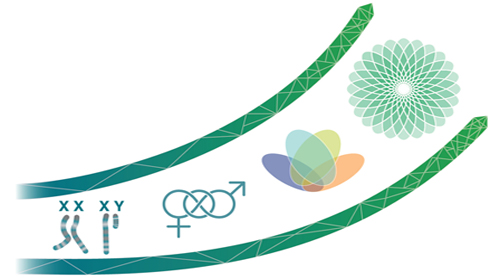Partnerships for Better Health – CIHR-ICRH Strategic Plan 2022-2025
Theme 2: Enhancing Equity, Diversity and Inclusion in Health Research
- The Challenge
- A Framework for Decision-Making
- A Unifying Approach
- Priority A: Preparing Future Capacity
- Priority B: Accelerating Knowledge Through Collaboration
- Priority C: Catalyzing Impact Through Knowledge Mobilization
- Theme 1: Strengthening Indigenous Health Research
- Theme 2: Enhancing Equity, Diversity and Inclusion in Health Research
- Strategic Plan in Action

Long description
The Institute is seen as a leader for advancing equity, diversity and inclusion (EDI) actions within mandate-focused strategic activities. The inclusion of EDI as a foundational theme within the current Institute strategic plan further emphasizes this leadership role within the circulatory and respiratory health research ecosystem.
Strategic Goal
To support EDI of ICRH researchers, research participants, funding opportunities, and stakeholders in circulatory and respiratory health research.
Past
Canada is a diverse nation with residents representing many social identities including, but not limited to, race, sex, gender and immigration status (21). It is well established that circulatory and respiratory diseases often present differently in men and women. Advancements have been made relating to sex and gender-based analysis plus (SGBA+), and ICRH has worked with partners to support sex and gender research (e.g., Women’s Heart and Brain Health Chair Awards), capacity development (e.g., Early Career Investigator Awards in Circulatory and Respiratory Health) and training programs (e.g., embedded trainee workshops).
In addition to sex and gender focused strategies, ICRH has included sex and gender considerations in Institute staffing, IAB membership and development of strategic peer review panels. For example, the current IAB membership meets the Government of Canada 50 – 30 Challenge where there is gender parity (“50%”) and significant representation (“30%”) of other under-represented groups (22).
As we better understand the contribution of age, race, ethnicity, sex and gender on the morbidity, mortality, health and wellness of individuals in Canada, further attention is needed on EDI to address the disproportionate representation of racialized populations, newcomers to Canada and those at the intersection of race, class, sexual orientation, physical ability and gender in circulatory and respiratory diseases.
Present
While advancements have been made related to SGBA+ historically, the significance of intersectionality has been underappreciated. In response, ICRH has led collaborative funding opportunities have purposefully incorporated EDI as a cross-cutting theme. Applicants were required to outline how their proposed research addressed EDI and include a plan to promote EDI in the research and work environment, the research design, methods, analysis, interpretation and/or KM efforts (e.g., Sepsis Research Network [Sepsis Canada], Heart Failure Research Network and Sleep Research Consortium).
ICRH is also promoting EDI in training through inclusion in annual training and early career development workshops and ICRH supported Health Research Training Platforms (HRTPs). The ICRH led TiC multi-Institute initiative team grant funding opportunity, supported by strategic partnerships, incorporated specific research areas focused on Mental Health Care for Black Youth, Transitions in Care for Adults (18 years and above) with Neurodiverse Conditions and Primary Care and Community Mental Health Care for Youth.
The COVID-19 pandemic has further highlighted how racialized populations in Canada are disproportionality represented in COVID-19 infections, vaccine accessibility and access to health care services. This highlights the ongoing need to expand efforts that ensure the researchers and participants are reflective of the diversity of the community being served.
Future
In the future, ICRH will actively build on previous commitments ensuring that EDI approaches are meaningfully embedded across activities or achieved through prioritizing racialized populations.
In addition, ICRH will continue to be responsive to the health research environment to address emerging EDI challenges, such as the need for representative samples in clinical research to accurately reflect the populations most severely affected. We are committed to co-creating and co-designing strategic opportunities that reflect and meaningfully engage the diversity of the ICRH community. As this priority evolves, ICRH will iteratively revise our EDI approaches into initiatives and activities to meet the dynamic needs of the circulatory and respiratory health research community.
Strategies
- 1) Promoting EDI Considerations
The Institute will promote research focused on EDI issues as well as include EDI strategies across all funding opportunities (e.g., Networks, Consortia and Teams).
- 2) Increasing Capacity
The Institute will expand opportunities that elevate researchers across the career trajectory (e.g., mid-career lecturer awards), encompassing sex and gender, intersectionality and racialized groups (e.g., featured researchers).
- 3) Ensuring Accessible Communications
The Institute will purposefully embed EDI strategies within Institute communications (e.g., slide decks, newsletters and social media), as well as Institute supported KM events (e.g., community dissemination events).
- 4) Empowering Diverse Leadership
The Institute will champion representation of historically excluded populations within ICRH staff, advisory boards, community events and strategic funding peer review panels.
- 5) Inspiring Meaningful Engagement
The Institute, in collaboration with partner organizations, will provide leadership to ensure barriers are removed for trainees to attend research events (e.g., travel awards) and that EDI considerations are implemented in the workshop agenda, speakers, panels and organizing committees.
- 6) Seeking Advice
The Institute will establish a bi-directional relationship with EDI communities and leaders and meaningfully engage with priority populations (e.g., remote and rural, newcomers to Canada, gender fluid, racialized peoples and intersectional populations).
- Date modified: